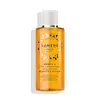What's inside
What's inside
 Key Ingredients
Key Ingredients

 Benefits
Benefits

 Concerns
Concerns

 Ingredients Side-by-side
Ingredients Side-by-side

Water
Skin ConditioningBetaine
HumectantGlycerin
HumectantPropanediol
SolventOryza Sativa Extract
AbsorbentPhyllostachys Pubescens Shoot Bark Extract
Skin ConditioningAspergillus Ferment
Skin ConditioningPanax Ginseng Root Extract
EmollientCyclodextrin
AbsorbentScutellaria Baicalensis Root Extract
AstringentHyaluronic Acid
HumectantBeta-Glucan
Skin ConditioningCellulose Gum
Emulsion StabilisingXanthan Gum
EmulsifyingButylene Glycol
HumectantUsnea Barbata Extract
Zanthoxylum Piperitum Fruit Extract
Skin ConditioningPulsatilla Koreana Extract
Skin ConditioningSodium Phytate
Tamarindus Indica Seed Gum
Emulsion StabilisingPolyglyceryl-10 Laurate
Skin ConditioningPolyglyceryl-10 Myristate
Skin ConditioningGlucose
Humectant1,2-Hexanediol
Skin ConditioningAlcohol
AntimicrobialLavandula Angustifolia Oil
MaskingLimonene
PerfumingLinalool
PerfumingWater, Betaine, Glycerin, Propanediol, Oryza Sativa Extract, Phyllostachys Pubescens Shoot Bark Extract, Aspergillus Ferment, Panax Ginseng Root Extract, Cyclodextrin, Scutellaria Baicalensis Root Extract, Hyaluronic Acid, Beta-Glucan, Cellulose Gum, Xanthan Gum, Butylene Glycol, Usnea Barbata Extract, Zanthoxylum Piperitum Fruit Extract, Pulsatilla Koreana Extract, Sodium Phytate, Tamarindus Indica Seed Gum, Polyglyceryl-10 Laurate, Polyglyceryl-10 Myristate, Glucose, 1,2-Hexanediol, Alcohol, Lavandula Angustifolia Oil, Limonene, Linalool
Water
Skin ConditioningHamamelis Virginiana Leaf Water
AstringentGlycerin
HumectantBetula Alba Juice
AstringentPEG-40 Hydrogenated Castor Oil
EmulsifyingVaccinium Myrtillus Fruit Extract
Skin ConditioningRubus Chamaemorus Fruit Extract
AntioxidantRubus Chamaemorus Seed Extract
Skin ConditioningPhenoxyethanol
PreservativePropanediol
SolventAscorbyl Glucoside
AntioxidantSodium PCA
HumectantSaccharum Officinarum Extract
MoisturisingSodium Hydroxide
BufferingCitrus Aurantium Dulcis Fruit Extract
MaskingCitrus Medica Limonum Fruit Extract
Skin ConditioningMaltodextrin
AbsorbentEthylhexylglycerin
Skin ConditioningDisodium EDTA
Acer Saccharum Extract
Skin ConditioningSodium Citrate
BufferingPotassium Sorbate
PreservativeCitric Acid
BufferingSodium Hyaluronate
HumectantSodium Benzoate
MaskingLinalool
PerfumingLimonene
PerfumingParfum
MaskingWater, Hamamelis Virginiana Leaf Water, Glycerin, Betula Alba Juice, PEG-40 Hydrogenated Castor Oil, Vaccinium Myrtillus Fruit Extract, Rubus Chamaemorus Fruit Extract, Rubus Chamaemorus Seed Extract, Phenoxyethanol, Propanediol, Ascorbyl Glucoside, Sodium PCA, Saccharum Officinarum Extract, Sodium Hydroxide, Citrus Aurantium Dulcis Fruit Extract, Citrus Medica Limonum Fruit Extract, Maltodextrin, Ethylhexylglycerin, Disodium EDTA, Acer Saccharum Extract, Sodium Citrate, Potassium Sorbate, Citric Acid, Sodium Hyaluronate, Sodium Benzoate, Linalool, Limonene, Parfum
 Reviews
Reviews

Ingredients Explained
These ingredients are found in both products.
Ingredients higher up in an ingredient list are typically present in a larger amount.
Glycerin is already naturally found in your skin. It helps moisturize and protect your skin.
A study from 2016 found glycerin to be more effective as a humectant than AHAs and hyaluronic acid.
As a humectant, it helps the skin stay hydrated by pulling moisture to your skin. The low molecular weight of glycerin allows it to pull moisture into the deeper layers of your skin.
Hydrated skin improves your skin barrier; Your skin barrier helps protect against irritants and bacteria.
Glycerin has also been found to have antimicrobial and antiviral properties. Due to these properties, glycerin is often used in wound and burn treatments.
In cosmetics, glycerin is usually derived from plants such as soybean or palm. However, it can also be sourced from animals, such as tallow or animal fat.
This ingredient is organic, colorless, odorless, and non-toxic.
Glycerin is the name for this ingredient in American English. British English uses Glycerol/Glycerine.
Learn more about GlycerinLimonene is a fragrance that adds scent and taste to a formulation.
It's found in the peel oil of citrus fruits and other plants such as lavender and eucalyptus. The scent of limonene is generally described as "sweet citrus".
Limonene acts as an antioxidant, meaning it helps neutralize free radicals.
When exposed to air, oxidized limonene may sensitize the skin. Because of this, limonene is often avoided by people with sensitive skin.
The term 'fragrance' is not regulated in many countries. In many cases, it is up to the brand to define this term. For instance, many brands choose to label themselves as "fragrance-free" because they are not using synthetic fragrances. However, their products may still contain ingredients such as essential oils that are considered a fragrance.
Learn more about LimoneneLinalool is a fragrance and helps add scent to products. It's derived from common plants such as cinnamon, mint, citrus, and lavender.
Like Limonene, this ingredient oxidizes when exposed to air. Oxidized linalool can cause allergies and skin sensitivity.
This ingredient has a scent that is floral, spicy tropical, and citrus-like.
Learn more about LinaloolPropanediol is an all-star ingredient. It softens, hydrates, and smooths the skin.
It’s often used to:
Propanediol is not likely to cause sensitivity and considered safe to use. It is derived from corn or petroleum with a clear color and no scent.
Learn more about PropanediolWater. It's the most common cosmetic ingredient of all. You'll usually see it at the top of ingredient lists, meaning that it makes up the largest part of the product.
So why is it so popular? Water most often acts as a solvent - this means that it helps dissolve other ingredients into the formulation.
You'll also recognize water as that liquid we all need to stay alive. If you see this, drink a glass of water. Stay hydrated!
Learn more about Water